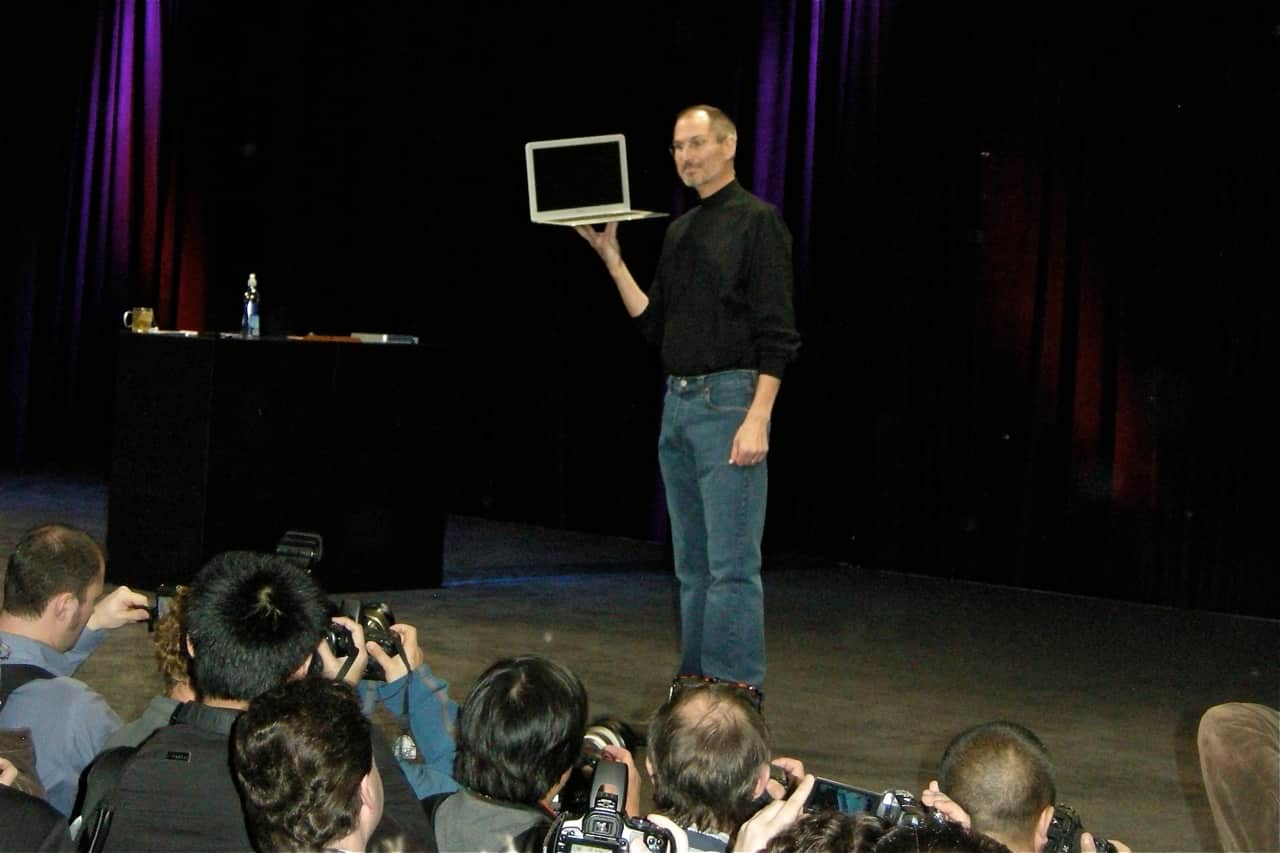Steve Jobs, the visionary co-founder of Apple Inc., was renowned for his charismatic stage presence and his ability to captivate audiences during his keynote addresses. These events were not just product launches; they were showcases of innovation, design, and Steve’s unwavering belief in pushing the boundaries of technology. In this article, we will delve into the top 10 Steve Jobs keynote addresses, exploring their significance and lasting impact on the world of technology.
10. iPad Introduction
Date: January 27, 2010
The introduction of the iPad marked a pivotal moment in Apple’s history. Leading up to this event, there was immense speculation and anticipation about Apple’s first tablet computer. Many expected a touch-screen version of Mac OS, but instead, they witnessed the birth of a new category of device—the iPad. This device was not just a larger version of the iPod Touch; it was a revolutionary product that would change the way people interacted with technology.
Table: Key Takeaways from the iPad Introduction
| Innovation | Impact |
|---|---|
| Birth of a new category | Changed how we use tablets |
| Introduction of iBooks | Revolutionized e-reading |
| Unique presentation style | Engaged the audience |
While some may argue that this keynote lacked the usual “wow” moments, it secured its spot in the top 10 due to the iPad’s subsequent success and the masterful presentation that highlighted its potential.
9. iPhone 4 Introduction
Date: June 7, 2010
The iPhone 4 introduction event was significant not only for showcasing a new iPhone but also for revealing several groundbreaking features. Steve Jobs promised “the biggest leap since the original iPhone,” and he delivered. This presentation introduced the world to the Retina display, a new antenna system, iOS 4, and FaceTime—a video calling feature that would change the way people communicated.
Table: Highlights from the iPhone 4 Introduction
| Feature | Impact |
|---|---|
| Retina display | Enhanced visual experience |
| FaceTime | Revolutionized video calls |
| Emphasis on design | Raised the bar for aesthetics |
Despite some technical hiccups during the presentation, this keynote was engaging and revealed a product that left a lasting mark on the smartphone industry.
8. iPod Introduction
Date: October 23, 2001
The introduction of the iPod in 2001 marked a historic moment for both Apple and the music industry. With its sleek design, user-friendly interface, and a five-gigabyte hard drive capable of holding up to 1,000 songs, the iPod revolutionized how people experienced music on the go.
Table: iPod’s Impact on the Music Industry
| Innovation | Impact |
|---|---|
| Seamless iTunes integration | Simplified music management |
| Introduction of the scroll wheel | Enhanced user experience |
The iPod’s launch expanded Apple’s market beyond computers and laid the foundation for their future dominance in portable devices. “A thousand songs in your pocket” became more than a tagline—it was a reality.
7. iTunes Music Store
Date: April 28, 2003
At a time when the music industry grappled with piracy and declining sales, Apple introduced the iTunes Music Store. Steve Jobs presented a solution to these challenges—a digital music store with a vast selection, unlimited CD burning, and fair pricing at 99 cents per song.
Table: iTunes Music Store Revolution
| Innovation | Impact |
|---|---|
| Legal digital music sales | Fought music piracy |
| User-friendly platform | Revolutionized music distribution |
The iTunes Music Store set the stage for the digital music revolution and laid the foundation for how consumers purchased and enjoyed music in the digital age.
6. MacBook Air Introduction
Date: January 15, 2008
Steve Jobs’s introduction of the MacBook Air showcased Apple’s relentless pursuit of innovation in the realm of portable computing. The MacBook Air was not just thin and light; it boasted a full-sized display and keyboard, breaking free from the constraints of traditional laptop design.
Table: MacBook Air’s Impact on Laptops
| Innovation | Impact |
|---|---|
| Thinnest notebook ever | Redefined laptop design |
| Multi-touch trackpad | Enhanced user interaction |
This presentation emphasized Apple’s commitment to pushing the boundaries of technology and design, setting a new standard for ultraportable laptops.
5. iCloud Introduction
Date: June 6, 2011
In his last product announcement, Steve Jobs unveiled iCloud—a service that moved the digital hub from individual devices to the cloud. Jobs highlighted the challenges of syncing devices and presented iCloud as the solution, ensuring that content remained up-to-date across all Apple devices.
Table: iCloud’s Impact on Cloud Services
| Innovation | Impact |
|---|---|
| Cloud-based synchronization | Simplified device management |
| Integration into apps | Streamlined user experience |
This presentation represented Jobs’s vision of a world dominated by post-PC devices, where content seamlessly moved across the cloud.
4. Mac OS X Introduction
Date: January 5, 2000
The introduction of Mac OS X marked a significant milestone in Apple’s operating system history. This keynote showcased Apple’s transition to a Unix-based architecture and introduced Aqua, a visually appealing user interface. Mac OS X laid the foundation for future macOS versions.
Table: Mac OS X’s Influence on Operating Systems
| Innovation | Impact |
|---|---|
| Unix-based architecture | Enhanced system stability |
| Aqua user interface | Set new design standards |
Steve Jobs’s demos highlighted the features that would define the macOS experience for years to come.
3. iMac Introduction
Date: May 6, 1998
The iMac introduction in 1998 marked a pivotal moment in Apple’s history. After a period of struggles, Jobs unveiled the iMac—a bold departure from conventional computer design. With its vibrant colors and built-in modem, the iMac was designed to make internet access simple and appealing.
Table: iMac’s Impact on Computer Design
| Innovation | Impact |
|---|---|
| Unique, colorful design | Redefined aesthetics |
| Emphasis on ease of use | Simplified computing |
The iMac’s success revived Apple’s image and set the stage for future innovations and product releases.
2. Macworld Boston ’97
Date: August 6, 1997
The Macworld Boston ’97 keynote is iconic for several reasons. At this event, Steve Jobs outlined his strategy to save Apple from its near-collapse. He announced a new board of directors, including himself, and unveiled a partnership with Microsoft—a surprising move that aimed to ensure Apple’s survival.
Table: Macworld Boston ’97 Key Highlights
| Announcements | Impact |
|---|---|
| New board of directors | Company leadership changes |
| Partnership with Microsoft | Controversial but strategic |
| Emphasis on Apple’s strengths | Charted a new path forward |
This keynote was pivotal in Apple’s history, as it laid the groundwork for the company’s resurgence.
1. iPhone Introduction
Date: January 9, 2007
Topping our list is the legendary iPhone introduction. On this day, Steve Jobs unveiled a device that would change the world—the iPhone. It wasn’t just a phone; it was a revolutionary combination of phone, iPod, and internet communicator. This keynote showcased innovation, design, and Steve’s unparalleled ability to create excitement.
Table: The iPhone’s Impact on Technology
| Innovation | Impact |
|---|---|
| Multi-functional device | Redefined mobile devices |
| Intuitive touch interface | Changed user interaction |
| App Store introduction | Revolutionized app economy |
The iPhone introduction was not just a product launch; it was a moment in history. It set the bar for smartphones and reshaped the entire tech industry.
Honorable Mentions
While these are the top 10 Steve Jobs keynote addresses, there are several honorable mentions that also left a mark on Apple’s journey and the world of technology. These include:
- Power Mac G3: Introduced as the “blue and white” Power Mac, it showcased Apple’s commitment to performance and design.
- iBook: The unveiling of the iBook with its unique design and rugged build for education left a lasting impression.
- iPod Nano: The introduction of the iPod Nano demonstrated Apple’s ability to miniaturize technology while maintaining functionality.
- Antenna Gate: Steve Jobs addressed the iPhone 4’s antenna issues, showcasing Apple’s willingness to admit imperfections and offer solutions.
- Original Macintosh: While not in the top 10, the original Macintosh launch was historic, representing Apple’s early commitment to innovation.
In conclusion, Steve Jobs’ keynote addresses were not just presentations; they were moments of inspiration and innovation. Each event showcased Apple’s commitment to pushing boundaries, embracing design, and changing the way we interact with technology. These presentations continue to inspire and serve as a testament to Steve Jobs’ enduring legacy in the world of technology.












